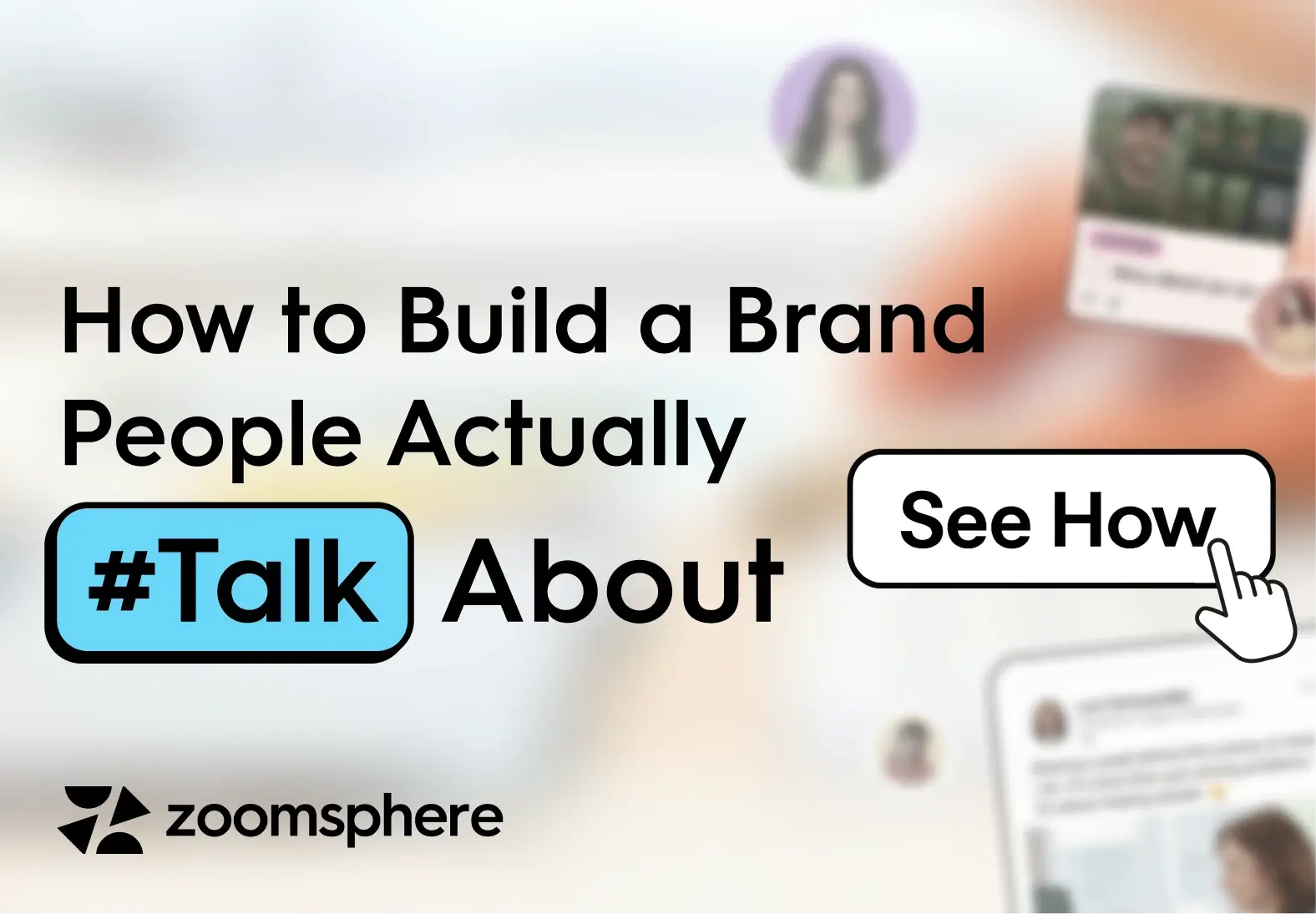How to Build a Brand People Actually Want to Talk About

Yes, your brand is posting. People are scrolling. And 99% of them couldn’t care less. Truth is… employee-generated content (that unpolished, selfie-in-bad-light, “this-is-what-I-do” stuff) pulls eight times more engagement than your carefully designed campaigns. Eight. Times.
Now, here’s the part that stings: 92% of B2B buyers trust what your employees post over anything your corporate account says. They believe Bob from IT over your $10k branded video. Why? Because humans trust humans. Logos are just… rectangles.
Right now, most brands are still duct-taping ads to the internet, praying for clicks. Meanwhile the ones winning have turned their teams into loud, believable, ridiculously shareable megaphones.
By the time you finish reading, you’ll know exactly how to make your brand the one people talk about—because your humans said so.
{{form-component}}
Your Own Team Is a Walking PR Machine (If You Let Them)
You know that polished campaign you spent a week crafting? It performs—barely. Whereas employee-generated content, the rougher, more human stuff your team actually posts, routinely outguns branded posts with 8× more engagement. Not even kidding.
This is math. When your people share content, they tap into networks your corporate logo can’t touch. Audiences don’t just tolerate peer voices—they crave them. That casual behind-the-scenes post from your operations lead has the reach your brand account wishes it could buy.
Here’s the acid test: organizations that lean into employee advocacy content rather than leaning on ads see serious returns—26% revenue growth. And just so we’re clear, that’s real growth, not vanity metrics.
What you’re ignoring is a bankable, breathing, kicking opportunity. Combine native team-generated content with a culture that backs employee brand storytelling, and you’ll suddenly be in market court—not playing from the bleachers.
What Talk-Worthy Brands Secretly Do Differently
Hint: It Starts at the Water Cooler
Some brands are talked about for the wrong reasons. Others are talked about because they’ve quietly built a system that turns their people into believable, unstoppable market voices. Not through luck. Not through “staff engagement” surveys. But by doing a handful of things with almost religious consistency.
Employees Are Believers
Talk-worthy brands don’t have to beg their people to post. Their employees genuinely believe in what they’re doing, and that belief naturally fuels authentic employee stories. This isn’t about “rah-rah” pep talks—it’s about giving employees something worth believing in and then letting them speak in their own voice. The payoff is… people connect with belief faster than they connect with branding.
They Build Internal Fame
If the only people getting public recognition are executives, you’re doing it wrong. Brands that generate buzz know the value of celebrating the middle of the org chart. When you publicly highlight an employee’s contribution, you don’t just make them feel valued—you create employee influencer content that’s more persuasive than any paid partnership you could run. It’s proof from the inside out.
%20(1).webp)
They Make Sharing Frictionless
If your employees have to dig through email chains for the “approved” image or figure out what to write from scratch, they won’t bother. The smartest brands make team-generated content easy to share: prepped visuals, caption starters, and clear timing cues. No “please share this” guilt trips—just plug-and-play relevance.
They Tie EGC Directly to KPIs
Talk-worthy brands don’t stop at “likes.” They measure exactly how employee-generated content impacts pipeline, retention, and revenue. For example, companies with active employee advocacy programs see up to higher revenue growth than peers without them. Measurement turns EGC from a fluffy “initiative” into a non-negotiable growth driver.
They Track Without Policing
The best brands know that over-policing employee content kills authenticity. Instead, they give teams planning and analytics tools—like ZoomSphere’s Scheduler—that help track reach and engagement without dictating tone. That balance means employees feel ownership, not oversight. And it works.
{{cta-component}}
Talk-worthy brands aren’t louder—they’re more believable. They’ve built the conditions for their employees to be genuine advocates and then gotten out of the way. That’s the “secret,” if you can call something this obvious a secret at all.
When Employees Speak, the Internet Listens
A brand post can be competent. An employee post can be catastrophic—for your competitors. There’s a reason employee-generated content has a gravitational pull that corporate updates just don’t.
Even structured programs have teeth. Brands that formalize an employee content strategy—with clear guidelines, accessible materials, and freedom for personal voice—have posted numbers like 27% higher online engagement and 19% more sales in just the first year. These are predictable outcomes when your most believable messengers start talking at scale.
Why It Works Every Time
People trust people. Always have. The tribal wiring is still there: we give more weight to a peer’s recommendation than a brand’s declaration. When employees speak publicly about their work, they’re not just pushing a product—they’re lending social credibility your brand can’t manufacture.
It’s also authority by proximity. Your team knows your product better than any external influencer ever could, and that knowledge translates into credibility. That’s why a casual post from a frontline worker can outperform the marketing team’s polished release—because it’s rooted in lived expertise, not campaign copy.
The Part Most Brands Still Miss
Your employees are the most believable megaphone you’ll ever own, but only if you let them keep their voice. Overly policing tone kills authenticity. The brands pulling jaw-dropping numbers aren’t the ones scripting every word—they’re the ones providing resources, analytics, and encouragement, then stepping back.
If you’re still treating employee posts as an afterthought, you’re not just leaving engagement on the table—you’re leaving revenue, reputation, and relevance wide open for someone else to claim.
Turn Your Staff Into the Internet’s Favorite Brand Ambassadors
Your employees already influence the market—you just haven’t been tracking it. Every time a team member talks about their work, their post lands in a feed that your brand account can’t touch. That’s the unfair advantage of employee-generated content—and most brands let it rot in the break room.
If you want to make employee social media sharing a growth engine instead of a happy accident, stop “hoping” for mentions and start building a repeatable content strategy.
1. Audit Employee Reach (Before You Pretend It’s Small)
First, get real numbers. How many followers does your team collectively reach? Look: it’s probably 10× more than your brand account. Without this baseline, you’re just guessing at the scale of the opportunity.
2. Identify Natural Advocates
You’re not looking for “influencers” with six-digit follower counts—you’re looking for employees who naturally tell stories, connect with peers, and post with a point of view. They’re your in-house media personalities. Protect them from corporate over-sanitizing.
3. Feed the Content Beast
If your employees have to beg for images, captions, or stats, you’ve already lost. Build a resource bank—post-ready graphics, key data points, and light-touch templates—so they can share in seconds, not hours. This isn’t controlling the message; it’s removing friction from participation.
4. Reward the Loudest Voices (Without Writing Checks)
Public recognition beats cash bonuses for advocacy longevity. Tag them in company updates, give shoutouts in all-hands, or feature their posts in internal newsletters. Being known inside the company for having an influential voice fuels more posting than most “social media challenges.”
{{form-component}}
5. Track Impact Like a Scientist
Measure engagement lift, referral traffic, and downstream revenue. Brands with formal employee advocacy programs report up to 26% higher revenue growth than peers. These are hard indicators that your staff-driven marketing is moving the needle.
6. Automate Without Killing Personality
Use scheduling and analytics tools like ZoomSphere to scale your program without turning posts into lifeless copy-paste jobs. Employees should still own their voice—you’re there to make distribution easier, not to sterilize it.
The brands winning right now don’t just let their employees talk—they give them a platform, amplify them, and measure the hell out of the results. If you still treat employee voices like “bonus content,” don’t be surprised when the internet gives its attention to the brand that doesn’t.
Your Brand’s Loudest Voice Is Probably Sitting in the Break Room
Employee-generated content isn’t cute extra credit—it’s the megaphone your brand keeps ignoring. Your official posts might look gorgeous, but let’s be honest: people scroll past them like they’re dodging an ex in the grocery store. Meanwhile, the casual post your customer support rep throws up on LinkedIn can outperform your entire campaign week. Logos don’t sell. People do.
And if your own team isn’t talking about you, why should anyone else?
A single employee post can reach ten times the audience of your brand account. Ten. Times. Yet most companies still treat their employees like silent billboards instead of human amplifiers.
Give your team the tools to share smarter, not harder. Stop pouring money into posts nobody trusts when the loudest, most believable voices are literally eating leftovers in your break room.












Heading 1
Heading 2
Heading 3
Heading 4
Heading 5
Heading 6
Lorem ipsum dolor sit amet, consectetur adipiscing elit, sed do eiusmod tempor incididunt ut labore et dolore magna aliqua. Ut enim ad minim veniam, quis nostrud exercitation ullamco laboris nisi ut aliquip ex ea commodo consequat. Duis aute irure dolor in reprehenderit in voluptate velit esse cillum dolore eu fugiat nulla pariatur.
Block quote
Ordered list

- Item 1
- Item 2
- Item 3
Unordered list
- Item A
- Item B
- Item C
Bold text
Emphasis
Superscript
Subscript



.webp)



.webp)
%20(1).webp)

